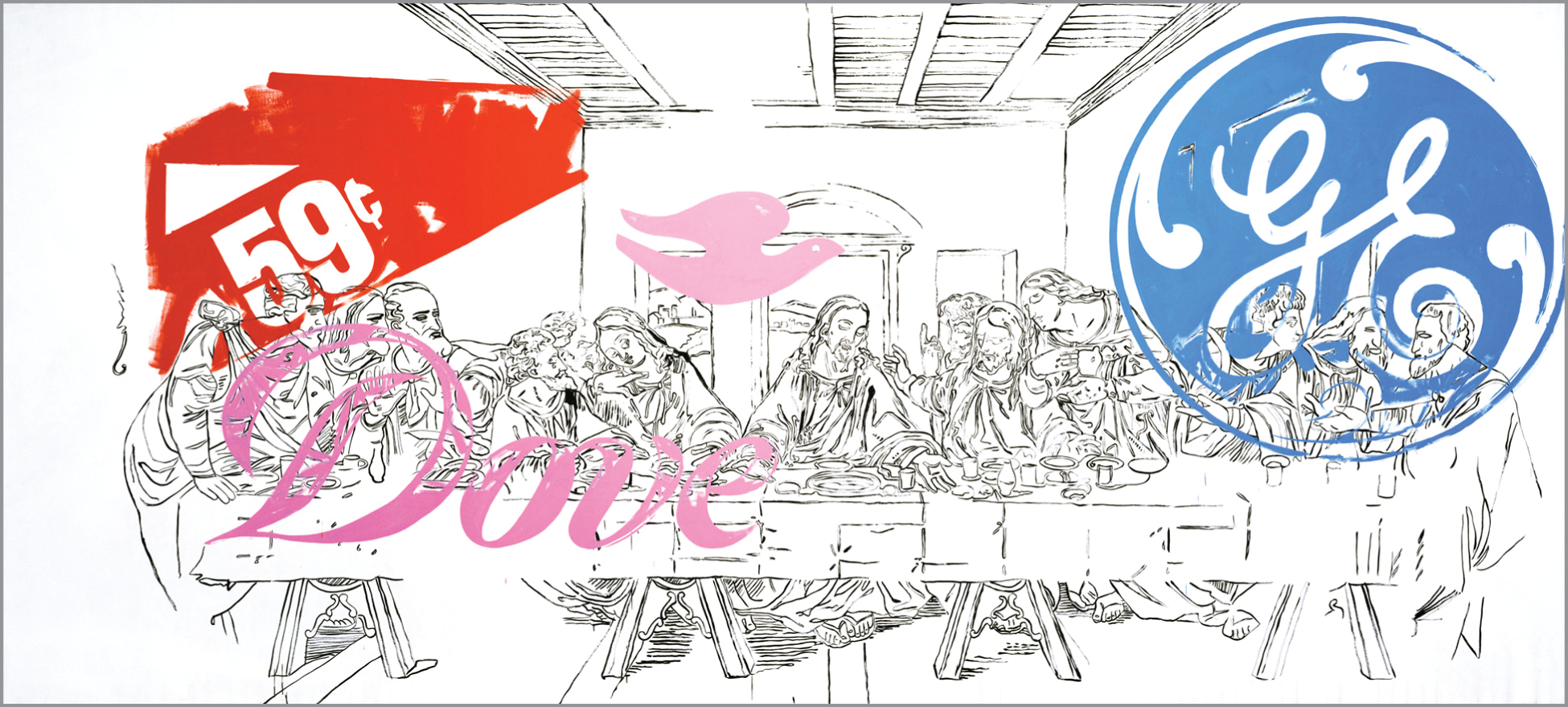Just as it is always best to start a story at the beginning, I suspect discussing an image from Andy Warhol’s arguable crowning achievement, his Last Supper series, is a very fitting way to end this course.
Milan
Commissioned in 1984 by Warhol’s longtime friend, the jet stetting Greek art dealer, collector, and fabulously homosexual Alexandre Iolas, Warhol created more than 100 versions of the Last Supper, both silk-screened and hand-painted, to inaugurate an exhibition space within Milan’s Palazzo Stelline Gallery, a former convent located less than 50 meters across the street from the Church of Santa Maria della Grazie, the home of Leonardo da Vinci’s then dilapidated 15th century masterpiece, Il Cenacolo or L’Ultima Cena.
Return to Painting
Unlike much of his better known works from the 1960s, 70s, and 80s, which were photo-mechanically silk screened often without his hand ever directly touching the canvas, this series of images marked a return for Warhol to “hand painting” and tracing, techniques he used in his decidedly homoerotic images from his early unsuccessful attempts to transition from commercial art to fine art in the 1950s.
Religious Iconography

More remarkably, the Last Supper series of images also marked the first time in Warhol’s career that he directly referenced religious iconography and themes. This final gesture is significant as it the first and only clue Warhol may have ever explicitly provided about his then unknown and previously unimaginable deep religious nature.
Corporate Logos
Superimposing profane American corporate logos for Dove soap and General Electric over da Vinci’s sacred, Andy Warhol’s massive 30 foot by 10 foot acrylic and silk screen ink on linen painting The Last Supper (Dove) mixes supermarket iconography with ubiquitous religious imagery to comprise an image that is either considered by some critics to constitute his most important work or by others as “wishy-washy, religiose” and “spiritless.”
Like all Pop artists of his time and since, yet perhaps better than all, Andy Warhol’s works allow audiences and critics alike to consider the oftentimes overlooked or long forgotten fundamental meaning and worth of everyday objects and images. For nearly five hundred years, Leonardo da Vinci’s masterpiece The Last Supper (circa 1495) had been replicated and reduced such innumerable ways that its meaning had been lost on viewers long before Warhol’s clever choice in 1984 to simultaneously hide and reveal its narrative beneath supermarket imagery of the 20th century.
Regarding what was to become his ultimate series of works, Warhol remarked to the flamboyant Australian arts writer Paul Taylor in his last known interview, “I painted them all by hand—I myself; so now I’ve become a Sunday painter… That’s why the project took so long [1984-1987]. But I worked with a passion.”
Andy was a religious painter?

For me, this series of images, and Last Supper (Dove) in particular, serves as a clear and almost obvious declaration to all and reminder to himself of all the ideals and ideas that shaped Warhol’s entire artistic output. Indeed, Warhol’s friend, collaborator, confidante, and biographer, Bob Colacello, says, “People don’t realize, Andy was a religious painter who created religious art for a secular world.”
At a memorial service in Manhattan several weeks after Andy Warhol’s death, Warhol’s friend, the art historian John Richardson, eulogized, “You [will] never understand Andy Warhol unless you know that he came from a very religious, Ukrainian Byzantine background and that he remained a church goer and a religious person through his whole life.” Richardson continued, “The knowledge of this secret piety inevitably changes our perception of an artist who fooled the world into believing that his only obsessions were money, fame, glamour, and that he could be cool to the point of callousness. Never take Andy at face value…”
For me, Andy Warhol will always be the man who killed the Renaissance beast, ART, and liberated and elevated mere ideas and questions to previously unconsidered levels. I might even go so far as to suggest Last Supper (Dove) not only celebrates any questions about the nature of ART; it elevates the very question “What is art?” to the level of art itself.
Precisely one month after the series debuted on January 22, 1987 in Milan, Andy Warhol died in his sleep in a New York Hospital after undergoing emergency gallbladder surgery.


Wonderful post Denis, thank you!
Do you see Warhol’s Last Supper as an allegory for The Factory? With, for example, Andy as Christ, and Valerie Solanas as Judas?